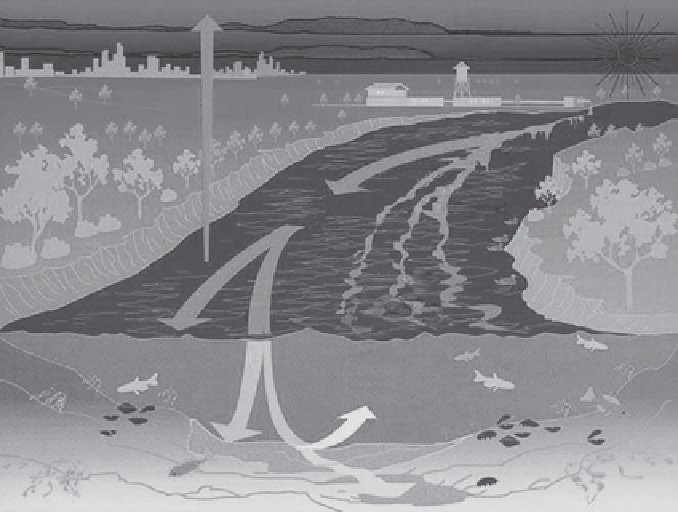Environmental Engineering Reference
In-Depth Information
estimating the contaminant flow involves averaging the streamflow variations and con-
taminant concentrations over a specified time interval. Conducting measurements at
multiple locations also provides a more accurate measure of the rates of streamflow and
contaminant transport.
Molecular diffusion also influences contaminant migration in surface water. Turbulent
flow is characterized by water moving in constantly changing and unpredictable patterns.
The swirls resulting from turbulent flow are called
eddies
, and they appear in many sizes,
volumes, and velocities. Random mixing of the water within eddies creates turbulent dif-
fusion and also influences mass transport. Wave action can create similar eddying effects
in lakes and other nonflowing water bodies.
Analytically, the transport rates for chemicals in surface water are expressed in terms
of flux density. Flux density is the mass of a chemical transported across an imaginary
surface of a unit area per unit of time (Equation 8.2; Hemond and Fechner-Levy 2000).
Fick's First Law (Equation 8.3) is also used to describe the flux density of mass transport
by turbulent dispersion (Hemond and Fechner-Levy 2000).
Figure 8.5 depicts a municipal or industrial waste water plant discharging to surface
water and many of the ensuing contaminant fate and transport processes, including
(USGS 1995a):
• Transport of discharged wastewater solute downstream
• Mixing due to turbulent advection and turbulent diffusion
• Photolysis
Municipal or industrial
sewage discharge
Volatilization
to atmosphere
Photolysis
Hydrolysis
Biodegradation
and
transformation
Sorption
onto sediments
Dilution
and
diffusion
Bioconcentration
Deposition and
resuspension
Deposition and
accumulation
FIGURE 8.5
(See color insert.)
Fate and transport effects in surface water. (From United States Geological Survey (USGS),
Contaminants in the Mississippi River, USGS Circular 1133, Washington, DC, 1995a.)

Search WWH ::

Custom Search